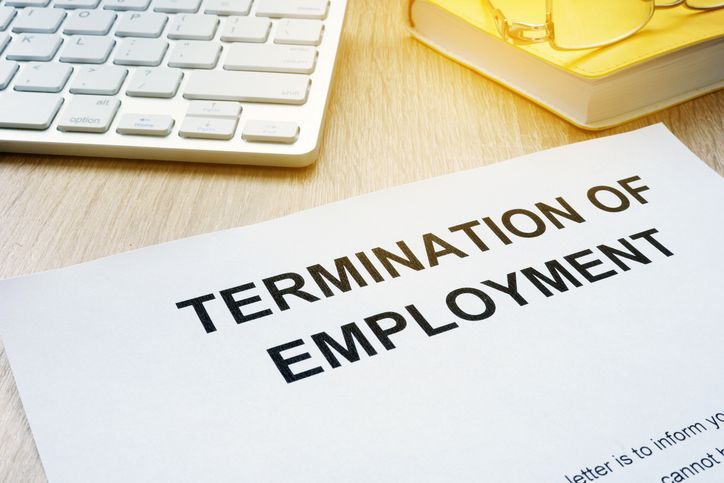
Preparing for a RIF?
Download our Essential Guide to Handling a Layoff
Request Pricing
Compare our rates to other providers
In the world of employment, few events carry as much weight as involuntary termination. It’s a term that denotes more than just the end of a job; it signifies a significant shift in the professional and personal lives of those involved. But exactly what does involuntary termination mean, what does it entail, and how does it differ from its voluntary counterpart?
In this article, we’ll dissect the concept of involuntary termination, exploring its causes, best practices for handling involuntary terminations, and its profound impact on both employers and employees. By gaining a deeper understanding of this critical aspect of employment dynamics, organizations can better navigate the complexities of involuntary termination and its aftermath.
What Is Involuntary Termination?
Let’s start by looking at how to explain the involuntary termination meaning at its core. Involuntary termination, often referred to simply as “termination,” is a significant event in employment relations where an organization ends the employment of an individual without the employee’s consent.
Causes of Involuntary Termination
There are several circumstances under which involuntary termination may occur. Let’s look at the most common situations that could result in involuntary termination.
- Performance issues: If an employee consistently fails to meet the expectations outlined in their job description or does not perform satisfactorily despite efforts to improve, the employer may decide to terminate their employment.
- Misconduct or policy violations: Employees who engage in misconduct such as theft, harassment, or violation of company policies and procedures may face termination as a disciplinary measure.
- Economic factors: In times of economic uncertainty, companies may resort to downsizing, restructuring, or layoffs to reduce costs. In such cases, employees may be involuntarily terminated due to factors beyond their control, such as budget constraints or a decline in business performance.
- Organizational changes: Mergers, acquisitions, or shifts in business strategies may lead to organizational changes that result in job redundancies or the elimination of certain positions, leading to involuntary termination for affected employees.
Involuntary termination can have significant implications for employees, including financial insecurity, loss of benefits, and emotional distress. It may also impact their future job prospects, as prospective employers may inquire about the circumstances surrounding their termination.
The Difference Between Voluntary and Involuntary Termination
When it comes to voluntary vs. involuntary termination, the distinction can often be obscured due to the misuse of terminology. However, it’s crucial for workers affected by either circumstance to understand their position clearly. To explain these disparities, let’s dive into their differences of voluntary and involuntary termination meaning, and how they influence future employment and benefits.
Starting with the basics, a voluntary termination occurs when an individual makes a deliberate decision that affects their employment status within an organization. This could involve choosing to pursue another job opportunity, opting for retirement, or accepting a voluntary layoff offer.
Now what if that individual is being fired? Despite common perception, most organizations classify being fired as a form of voluntary termination. This is because the individual’s actions directly contribute to their termination, whether that is violating company policies, failing to meet performance standards, or engaging in misconduct. Even though no one desires to be fired, the act itself stems from the individual’s choices or actions.
On the other hand, an involuntary termination arises from a business decision beyond the employee’s control. For instance, economic downturns or financial challenges may prompt a company to initiate layoffs. In such cases, employees are let go not due to their performance or actions, but rather as a result of broader organizational circumstances, leaving them with no agency in the matter.
Involuntary Termination Benefits
One of the most significant contrasts between the two types of terminations lies in how benefits are managed.
In the case of involuntary termination, there are often accompanying perks for the employee, such as a severance agreement and outplacement services. A severance agreement delineates the terms and conditions of the termination, offering the departing employee a financial sum in exchange for their agreement not to pursue legal action against the company.
These agreements benefit both parties, providing the departing employee with financial support during their job search while safeguarding the company from potential legal disputes. Therefore, a well-crafted severance agreement should be mutually beneficial.
Outplacement services are also offered to departing employees, assisting them in finding new employment opportunities more swiftly than if they were to navigate the process alone. By utilizing job coaches, online resources, and advanced methodologies, outplacement providers alleviate much of the stress associated with layoffs, ultimately aiding the company in maintaining its reputation and facilitating its recovery.
As evident, involuntary terminations are typically accompanied by a support system, recognizing the challenges inherent in the layoff process. Additionally, affected employees may qualify for unemployment benefits, although eligibility criteria vary based on the circumstances of the layoff and other relevant factors.
Voluntary Termination Benefits
But what about voluntary terminations? When an individual voluntarily resigns from a company, benefits are typically not extended. This rationale is quite understandable. For instance, if someone submits their two-week notice and subsequently leaves the organization, they are unlikely to receive a severance agreement or outplacement package. This is because they are likely departing for another opportunity or personal reasons, and the company isn’t obligated to provide such benefits to protect itself.
The same principle applies to retirements and similar circumstances. In most cases, individuals retiring have already planned their next steps and are leaving to pursue those plans.
This also applies to terminations due to misconduct or policy violations. When someone is fired, it’s typically because they’ve violated company policies or engaged in misconduct. This voluntary action by the employee enables the company to terminate their employment without the complexities or benefits associated with layoffs.
The exception to this is when an individual accepts a voluntary layoff package. In such cases, the employee is willingly stepping down to assist the company with its challenges. Many find this type of voluntary layoffs attractive due to the severance and outplacement benefits offered.
For example, if a worker was contemplating leaving, but hasn’t decided on their next career move, a voluntary layoff package can facilitate their transition. Traditionally, voluntary layoffs are one of the few forms of voluntary termination that offer various perks.
Best Practices for Involuntary Termination
Involuntary terminations such as layoffs or restructuring can be complex and sensitive situations that require careful planning and communication to minimize negative impact on employees and maintain organizational stability. Here are some best practices for handling these types of involuntary terminations.
- Develop a clear plan: Before implementing layoffs or restructuring, develop a clear plan that outlines the reasons for the action, the criteria for selecting affected employees, and the timeline for implementation. Ensure that the plan aligns with organizational goals and values.
- Communicate transparently: Communicate openly and transparently with employees about the reasons for the layoffs or restructuring, as well as the potential impact on the organization and individuals. Provide as much information as possible while respecting confidentiality and legal considerations.
- Offer support services: Provide affected employees with support services such as career counseling, resume writing assistance, job search resources, and access to outplacement services like Careerminds’ industry-leading outplacement program. Offering support can help employees navigate the transition more effectively and mitigate the impact on their livelihoods.
- Consider alternatives: Before resorting to layoffs or restructuring, explore alternatives such as hiring freezes, reduced work hours, voluntary leave programs, or reassignment of employees to other roles or departments. Consider the long-term implications of the decision and explore all possible options to minimize the need for involuntary terminations.
- Follow legal requirements: Ensure compliance with legal requirements and regulations governing layoffs or restructuring, including requirements for notification, severance pay, and benefits continuation. Consult legal counsel to ensure that the process adheres to relevant laws and regulations.
- Treat employees with dignity and respect: Conduct layoffs or restructuring with empathy, dignity, and respect for affected employees. Acknowledge their contributions to the organization and express gratitude for their service, even in difficult circumstances.
- Provide timely and accurate information: Keep employees informed throughout the process with timely and accurate information about the status of layoffs or restructuring efforts, as well as any updates or changes to the plan. Address questions and concerns openly and honestly.
- Support remaining employees: Provide support and reassurance to remaining employees who may be feeling anxious or uncertain about the future. Communicate the organization’s commitment to supporting them through the transition and maintaining a positive work environment.
- Evaluate and learn: After the layoffs or restructuring is completed, conduct a thorough evaluation of the process to identify strengths, weaknesses, and areas for improvement. Learn from the experience to inform future decision-making and improve practices for handling involuntary terminations.
- Maintain morale and engagement: Take proactive steps to maintain morale and engagement among remaining employees following layoffs or restructuring. Provide opportunities for open communication, recognition, and support to help rebuild trust and morale within the organization.
By following these best practices, organizations can navigate layoffs or restructuring with sensitivity, fairness, and professionalism, minimizing the negative impact of involuntary termination on employees and preserving the organization’s reputation and culture.
Involuntary Termination: Key Takeaways
Involuntary termination stands as a pivotal moment in the landscape of employment, representing more than just the cessation of a job, but a profound transition for both employer and employee alike. Throughout this article, we’ve unraveled the complexities surrounding involuntary termination, examining its causes, legal considerations, and far-reaching implications.
As organizations navigate the intricacies of involuntary termination and its aftermath, it’s imperative to foster an understanding of the process and its impact on individuals. By recognizing the nuances of involuntary termination, employers can approach this delicate matter with sensitivity and professionalism, mitigating the challenges faced by affected employees and safeguarding the integrity of the organization.
Here are the key takeaways:
- Involuntary termination refers to the ending of an individual’s employment by their employer, often for reasons beyond the individual’s control.
- Causes of involuntary termination may include performance issues, misconduct or policy violations, economic factors, and organizational changes.
- Voluntary termination refers to when an individual voluntarily resigns from a company.
- Causes of voluntary termination may include leaving for a new job, retirement, or personal reasons.
- Involuntary termination can have significant implications for employees, including financial insecurity, loss of benefits, and emotional distress.
- Involuntary terminations are typically accompanied by benefits such as severance agreements and outplacement services to support affected employees in their transition.
If you’re looking for support with involuntary terminations and would like to learn more about outplacement benefits, click below to speak with one of our experts and learn more about Careerminds’ outplacement offerings.
In need of outplacement assistance?
At Careerminds, we care about people first. That’s why we offer personalized talent management solutions for every level at lower costs, globally.



